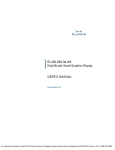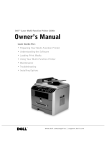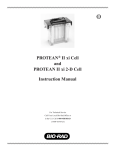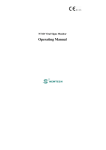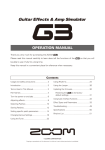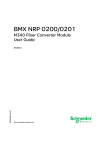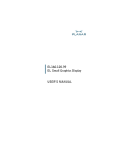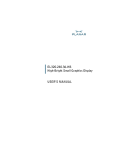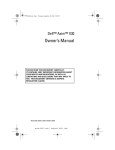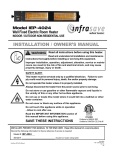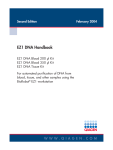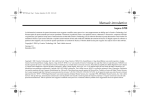Download MODEL 2128 FRACTION COLLECTOR - Bio-Rad
Transcript
MOD E FRA L 2128 CTIO N CO L LEC TOR Thre sh Next old tu Drain be 2 in ADV g COL L STO P 7 4 1 HELP CE 8 5 2 0 9 6 3 . MODEL 2128 FRACTION COLLECTOR INSTRUCTION MANUAL Catalog Numbers 731-8123 731-8124 Table of Contents TABLE OF CONTENTS Safety ................................................................................................................................................... 3 Section 1.0 1.1 1.2 1.3 1.4 1.5 Introduction .................................................................................................................... Overview .......................................................................................................................... Features ........................................................................................................................... Unpacking ........................................................................................................................ Physical Description ......................................................................................................... Dispenser Arm Positions .................................................................................................. Section 2.0 Front and Rear Panel Controls and Connectors ......................................................... 10 Section 3.0 System Configurations and Plumbing ......................................................................... 3.1 System Configurations ..................................................................................................... 3.1.1 Connection to a Bio-Rad Econo System and Automated Econo System ........... 3.1.2 Connection to Bio-Rad’s Econo Components ..................................................... 3.1.3 Connection to Non-Bio-Rad Components ........................................................... 3.2 Plumbing .......................................................................................................................... 4 4 5 5 7 8 14 14 15 16 17 19 Section 4.0 Stand-Alone Operation .................................................................................................. 22 Section 5.0 Operation with the Econo System and Automated Econo System ........................... 34 Section 6.0 Maintenance and Troubleshooting ............................................................................... 38 6.1 Maintenance ..................................................................................................................... 38 6.2 Troubleshooting ................................................................................................................ 39 Appendix A Appendix B B.1 B.2 Appendix C Appendix D Appendix E Appendix F Appendix G Tube Rack Options ......................................................................................................... Delay Function ................................................................................................................ Determining Delay ............................................................................................................ Examples of Delay Function ............................................................................................. Bubble Filter Time .......................................................................................................... Connection to Bio-Rad's HPLC System ....................................................................... Rear Panel Connector Information ............................................................................... Specifications ................................................................................................................. Warranty and Ordering Information ............................................................................. 40 42 42 43 46 47 48 50 52 1 Table of Contents LIST OF FIGURES 1. Model 2128 Fraction Collector, shown with Rack #1 ................................................................. 2. The Fittings Kit ........................................................................................................................... 3. Physical Features of the Fraction Collector ............................................................................... 4. Dispenser Arm Positions ............................................................................................................ 5. Connecting the Fraction Collector to an Econo System ............................................................. 6. Connecting the Fraction Collector to Econo Components ......................................................... 7. Connecting the Fraction Collector to Components other than Bio-Rad’s ................................... 8. Stand-alone Mode Menu Tree ................................................................................................... 9. Econo Mode Menu Tree ............................................................................................................. 10. Cleaning the Drop Head Window ............................................................................................... B-1. Example showing Collect All Method with a Delay of 0.2 Minutes ............................................. LIST OF TABLES 1. Front Panel Controls .................................................................................................................. 2. Rear Panel Connectors .............................................................................................................. 3. Plumbing a Fraction Collector .................................................................................................... 4. Plumbing a Fraction Collector with the Optional Diverter Valve ................................................. 5. Stand-alone Operation using the Collect All Method ................................................................. 6. Stand-alone Operation using the Time Windows Collection Method ......................................... 7. Stand-alone Operation using the Peak Collection by Threshold Detection Method .................. 8. Stand-alone Operation using the Peak Collection by Threshold Detection with Time Windows Method ....................................................................................................... 9. Operation of the Fraction Collector from the Econo System ...................................................... 4 6 7 9 15 16 17 33 37 38 43 10 12 19 20 23 25 27 30 35 2 Safety SAFETY ! Caution/Warning Disconnect power to the Fraction Collector before servicing. No user-serviceable parts are inside. Refer servicing to Bio-Rad service personnel. This instrument is intended for laboratory use only. This product conforms to the "Class A" standards for electromagnetic emissions intended for laboratory equipment applications. It is possible that emissions from this product may interfere with some sensitive appliances when placed nearby or in the same circuit as those appliances. The user should be aware of this potential and take appropriate measures to avoid interference. This Bio-Rad Model 2128 Fraction Collector is designed and certified to meet I.E.C. 1010* safety standards, and it meets the compliance requirements of CISPR 11A** for conducted and radiated electromagnetic emission. Certified products are safe to use when operated in accordance with the instruction manual. This safety certification does not extend to other chromatography equipment or accessories not I.E.C. 1010 certified, even when connected to this Fraction Collector. This instrument should not be modified or altered in any way. Alteration of this instrument will void the manufacturer’s warranty, void the I.E.C. 1010 certification, and create a potential safety hazard for the user. Bio-Rad is not responsible for any injury or damage caused by the use of this instrument for purposes other than for which it is intended or by modifications of the instrument not performed by Bio-Rad or an authorized agent. Avoid contact with dispenser arm slot or diverter valve while unit is in operation. Diverter valve shall be handled only while installing, removing or plumbing valve according to procedures outlined in the instruction manual. Otherwise, inaccurate dispenser arm positioning or interruption of programmed collector method may result. *I.E.C. 1010 is an internationally accepted electrical safety standard for laboratory instruments. **CISPR 11A is an internationally accepted standard for conducted and radiated electromagnetic emission. 3 Introduction 1.0 INTRODUCTION 1.1 OVERVIEW The Model 2128 Fraction Collector is used for automatic fraction collection in a variety of laboratory applications. It may be used as a stand-alone unit or as part of Bio-Rad’s Econo System and HPLC chromatography instruments. The Model 2128 Fraction Collector is microprocessor controlled, with easy-to-use front panel controls and a menu-driven software interface for method setup. Instrument operation may be initiated from the front panel or by command from an external source. When not in use, the tube rack may be removed and the dispenser arm rotated to its storage position to minimize space requirements. MOD E FRA L 2128 CTIO N CO L LEC TOR Thre sh Next old tu Drain be 2 in ADV g COL L STO P 7 4 1 HELP CE 8 5 2 0 9 6 3 . Figure 1. Model 2128 Fraction Collector, shown with Rack #1 4 Introduction 1.2 FEATURES The Model 2128 Fraction Collector provides a number of features, including the following: • Collection into microplates, microtubes, test tubes (12 mm to 18 mm in diameter and any height up to 180 mm), and bottles of any size • Collection by drop count or time; collection by volume when under Econo System control • Collection over the entire run, using Time Windows, Peak Detection, or combinations of Time Windows and Peak Detection • Optional diverter valve for flow diversion and to minimize spillage during tube changes • Menu-driven software for ease of programming • Ability to start/stop an external pump and chart recorder • Accepts a range of UV signal inputs for peak collection • Rotating arm and removable racks minimize space requirements • Removable drain trough for easy cleaning • On-screen help function 1.3 UNPACKING When you receive the Fraction Collector, carefully inspect the containers for any damage which may have occurred in shipping. Severe damage to a container may indicate damage to its contents. If you suspect damage to the contents may have occurred, immediately file a claim with the carrier in accordance with their instructions before contacting Bio-Rad Laboratories. The Fraction Collector and the standard tube rack (Rack #1) are shipped in separate cartons. Open the shipping cartons. ! Caution Do not lift the Fraction Collector by its dispenser arm! 5 Introduction Lift the Fraction Collector out of its packing. Do not lift the unit by its dispenser arm. Remove the remaining contents of each of the boxes and check all of the parts against the supplied packing list. The Model 2128 Fraction Collector is shipped with the following: • Fraction Collector unit • AC power cord • Fittings kit (shown in Figure 2 below) • User Manual • Tube rack #1 (1) • Drain tubing If any part is missing or damaged, contact Bio-Rad Laboratories immediately. 5 4 2 1 3 Item Number 1 2 3 4 5 Quantity 1 4 4 1 1 Contents of Fittings Kit 1.5 meters Tefzel® Tubing, 1/16" OD, .020" ID Fittings, 1/4-28, 1/16" OD Ferrules, 1/16" OD Union, Luer to 1/4-28 Combicon connector (separate) Figure 2. The Fittings Kit 6 Introduction 1.4 PHYSICAL DESCRIPTION Refer to Figure 3 for the following discussion. INLET TUBING TUBING GUIDES MOD E FRA L 2128 CTIO N CO L DRAIN TROUGH DISPENSER ARM LEC TOR SOCKET FOR OPTIONAL DIVERTER VALVE Thre sh Next old tu Drain be 2 in ADV g COL L STO P 7 4 1 HELP POWER SWITCH CE 8 5 2 0 DROP HEAD DRAIN TUBING 9 6 3 . RACK POSITIONING GUIDES Figure 3. Physical Features of the Fraction Collector Component Function Rack Positioning Guides Accurate dispensing requires that the rack be positioned in the rack positioning guides. The rack is designed so that only the feet on one side can be positioned in the guides. This ensures that the front of the rack faces forward, and that the rack is accurately positioned to receive fractions. Dispenser Arm Moves the drop head in a serpentine X-Y motion over each of the collection tubes. The dispenser arm may be rotated 90° using the green tab at its axis. Drop Former The drop former is located in the drop head. The drop former accepts 1/4-28 fittings. 7 Introduction Component Function Drop Head Consists of the drop former, a photo diode cell for drop counting, and a clear glass tube to protect the photo diode cell from splashes. The inlet tubing is connected to the drop former, which provides uniform drop size. Drain Trough Fluid designated as waste is emptied into the drain trough which drains toward the back of the unit. Approximately 0.5 meters of 1/4" ID, 3/8" OD, 1/16" wall, Tygon tubing is provided to direct the flow out of the drain trough. Inlet Tubing The tubing which runs from the detector or the diverter valve to the drop former. 1/16" OD, 0.020" ID Tefzel® tubing is supplied with the unit. Socket for (Optional) Diverter Valve A diverter valve may be mounted on the drop head to control the flow of fluid and to minimize spillage during tube changes. This diverter valve is available as an option. (Refer to Appendix G for ordering information.) 1.5 DISPENSER ARM POSITIONS The dispenser arm can be rotated to conserve bench space when the Fraction Collector is not being used. There are three positions for the dispenser arm, as shown in Figure 4 and discussed below. Rotating the dispenser arm requires first lifting the green tab at the axis end of the arm. Note: Be sure the Fraction Collector is turned off before manually moving the arm. REAR OF UNIT STORAGE REAR OF UNIT STOW REAR OF UNIT PARK Figure 4. Dispenser Arm Positions 8 Introduction • Storage position: The Fraction Collector is shipped with the dispenser arm in its Storage position. To • Stow position: The arm must be in Stow position (at the front of the unit) before it can be rotated for conserve bench space when the Fraction Collector is not being used, the dispenser arm may be returned to the Storage position from the Stow position. The Storage position must be used when shipping the unit. storage. If power is off, the arm may be moved manually to this position. Alternatively, Stow may be selected from the Mode menu. Before rotating the arm between the Storage and Stow positions, the Fraction Collector must be turned off. To rotate the arm, lift and hold the green tab at the arm’s axis end and then rotate the other end of the arm. • Park position: Always ensure that the arm is in the Park position (at the rear of the unit) before turning power on. The arm must be moved manually with the power off. The arm will initialize itself over its X-Y motion when power is turned on. Some noise will occur during this operation. After each run, the dispenser arm automatically returns to its Park position. If the arm is ever moved accidentally, turn the unit off and manually move the arm to the Park position before turning the power back on. Turning the unit on with the arm out of the Park position will cause some noise to occur as the arm attempts to initialize. This is not detrimental to the Fraction Collector. When a collection method is programmed and the READY soft key is pressed, the arm will move to a position over the drain trough nearest to the start tube. (If the optional diverter valve is installed, the drop head moves over the start tube.) Pressing RUN then starts the collection method. 9 Front and Rear Panel Controls and Connectors 2.0 FRONT AND REAR PANEL CONTROLS AND CONNECTORS Table 1. Front Panel Controls DRAIN TROUGH MODEL 2128 FRACTION COLLECTOR STATUS AND CONTROL PARAMETERS (3 LINES) Threshold Next tube 2 Draining ADV COLL MENU SELECTIONS STOP SOFT KEYS (FOR MENU SELECTION) CURSOR CONTROL KEYS HELP 7 8 9 4 5 6 1 2 3 CE 0 . NUMERIC KEYPAD DECIMAL KEY CLEAR ENTRY KEY HELP KEY POWER ON/OFF SWITCH Key Description Cursor Control keys: Allow you to move the cursor on the LCD up, down, left or right. Soft keys: These four keys are located directly below the LCD display. The function each key executes depends on the menu selection displayed above it. Menu selections change depending on where you are in the menu hierarchy. 10 Front and Rear Panel Controls Table 1. (continued) Front Panel Controls Key HELP Description Help key: Pressing this key at any time will display information on how to use the unit. Use the NEXT and LAST soft keys to scroll through the Help screens. CE Clear Entry key: To clear a cursor field. . Decimal key: To enter a decimal value. 11 Front and Rear Panel Controls and Connectors Table 2. Rear Panel Connectors REC I/O 10mV 100mV 1V 10mV 100mV 1V REC I/O ANALOG IN ANALOG GND ANALOG IN ANALOG GND Connector 10mV 100mV 1V Description Analog Input Range Select switch: When the Fraction Collector is connected to an external UV monitor, this switch setting must correspond to the UV monitor’s output. I/O I/O connector: This 15-pin D connector is used for connecting the following: • A Model ES-1 Econo System Controller or a Model EP-1 Econo Pump. The Econo System Controller or Econo Pump controls the Fraction Collector. • External pump. The Fraction Collector starts and stops the pump. (The pump must have compatible control circuitry logic. Refer to Appendix E.) 12 Front and Rear Panel Controls and Connectors Table 2. (continued) Rear Panel Connectors Connector Description REC REC connector: This 8-pin mini-DIN connector is for connecting the following: • A Model ES-1 Econo System Controller. The Econo System controls the Fraction Collector’s diverter valve (optional). • A stand-alone chart recorder. The Fraction Collector controls the chart recorder. (The chart recorder must have compatible control circuitry logic. Refer to Appendix E.) ANALOG IN ANALOG GND Combicon connector: For connecting a UV monitor. This allows the Fraction Collector to accept signals for Peak Detection by Threshold. (Refer to in Chapter 4.) 13 System Configurations and Plumbing 3.0 SYSTEM CONFIGURATIONS AND PLUMBING 3.1 SYSTEM CONFIGURATIONS The Model 2128 Fraction Collector can be operated in either of the following configurations: • With a Bio-Rad Econo System, in which the Econo System controls the operation of the Fraction Collector. Fraction size (in ml) is set on the Econo Pump. This configuration is discussed in section 3.1.1. • With Bio-Rad Econo components, such as the Model EP-1 Econo Pump, a Model EM-1 Econo UV Monitor and/or a Model 1325, 1326, or 1327 Econo Recorder. When connected to the Model EP-1 Econo Pump, the pump controls the Fraction collector. If the Econo Pump is not used, the Fraction Collector provides complete control of fraction collection. This configuration is discussed in section 3.1.2. • With non-Bio-Rad components, such as a pump, a UV monitor, and/or a chart recorder. The Fraction Collector may be used to start/stop a pump, and it provides complete control of fraction collection. This configuration is discussed in section 3.1.3. Note: Before proceeding, make sure power is turned off to each component to be connected. Also, be sure to use a grounded, surge protected outlet when plugging in the power cables. 14 System Configurations and Plumbing 3.1.1 Connection to a Bio-Rad Econo System and Automated Econo System To connect a Model ES-1 Econo System Controller or to a Model EP-1 Econo Pump to the Model 2128 Fraction Collector, use Econo System Cable #15 (15-pin to mini-DIN). If the Fraction Collector’s diverter valve is to be used, you will also need Econo System Cable #3 (mini-DIN to mini-DIN) for valve control from the Econo System Controller or Econo Pump. The diverter valve and the cable are purchased separately. In this configuration, the SV-3 valve must be removed from the Econo System. ECONO PUMP CONNECT TO EXTERNAL ECONO PUMP OR TO ECONO SYSTEM CONTROLLER ECONO SYSTEM CABLE #15 ECONO SYSTEM CABLE #3 USED ONLY WHEN THE OPTIONAL DIVERTER VALVE IS MOUNTED ON THE FRACTION COLLECTOR'S DROP HEAD Figure 5. Connecting the Fraction Collector to an Econo System 1. Connect the Fraction Collector to the Model ES-1 Econo System Controller using Econo System Cable #15 (15-pin D to mini-DIN cable). a. Connect the cable’s 15-pin D connector to the port labeled I/O on the Fraction Collector. b. Connect the mini-DIN connector to the port labeled on the Econo System Controller. 2. If the Fraction Collector's diverter valve will be used, connect the Econo System Controller to the Fraction Collector using Econo System Cable #3 (mini-DIN to mini-DIN cable). (The Econo System’s Model SV-3 valve must be removed.) a. Connect the cable’s mini-DIN connector to the REC port on the Fraction Collector. b. Connect the other mini-DIN connector to the port on the Econo System Controller. 3. Connect all power cords to available grounded, surge protected outlets. 4. To plumb the Fraction Collector, follow the procedure in section 3.2. Then follow the procedure in Chapter 5, Operation with the Econo System. 15 System Configurations and Plumbing 3.1.2 Connection to Bio-Rad’s Econo Components The following configuration shows the Fraction Collector set up with a Model EP-1 Econo Pump, a Model EM1 Econo UV Monitor, and/or a Model 1325, 1326, or 1327 Econo Recorder. This simple isocratic system allows full use of the Fraction Collector’s advanced programming features. This configuration requires Econo System Cable #16, Econo System Cable #7, and two bare wires. Note that the Model EP-1 Econo Pump is not connected to the Fraction Collector. Use the Vt function on the Econo Pump to stop solvent delivery after the required volume. ECONO RECORDER FRACTION COLLECTOR CHANNEL 1 ECONO UV MONITOR ECONO PUMP NO CONNECTION TO FRACTION COLLECTOR BARE WIRES ECONO SYSTEM CABLE #7 ECONO SYSTEM CABLE #16 Figure 6. Connecting the Fraction Collector to Econo Components 1. Connect the Fraction Collector to the Econo Recorder using Econo System Cable #16 (mini-DIN-toDIN cable). a. Connect the 8-pin mini-DIN connector to the port labeled REC on the Fraction Collector. b. Connect the DIN connector to the Channel 1 DIN port on the Econo Recorder. 2. Connect the Econo EM-1 UV Monitor to the Econo Recorder using Econo System Cable #7 (mini-DIN to breakout cable). a. Connect the 8-pin mini-DIN connector to the Econo UV Monitor’s recorder port. b. Connect the positive (+) wire to the Econo Recorder’s channel 1 (+) banana plug socket. Connect the ground (–) wire to the channel 1 (–) banana plug socket. This provides 0 V to 1 V AUFS. (Refer to the documentation for the Econo Recorder and the Econo UV Monitor for instructions on making connections to these units.) 16 System Configurations and Plumbing 3. Connect the Fraction Collector to the Econo EM-1 UV Monitor, via the Econo Recorder. a. The Fraction Collector’s UV input is connected in parallel to the Econo Recorder. To do this, connect the bare wires between the Econo Recorder’s channel 1 banana plug’s (+) and (–) connectors and the Fraction Collector’s male Combicon Analog IN and Analog OUT connector using the female Combicon connector supplied with the fittings kit, shown in Figure 2. b. Set the Analog Input Range Select switch to 1 V. 4. Connect the power cord to an available grounded, surge protected outlet. 5. To plumb the Fraction Collector, follow the procedure in section 3.2. Then follow the procedure in Chapter 4, Stand-Alone Operation. 3.1.3 Connection to non-Bio-Rad Components To connect the Fraction Collector to a non-Bio-Rad pump, UV monitor, and/or chart recorder, you will need the Model 2128 Accessory Cable (15-pin to bare wires), Econo System Cable #7 (mini-DIN to bare wires), and two bare wires. In addition, the pump and chart recorder circuit logic must be Start/closed circuit=ON; Stop/open circuit=OFF. The UV monitor’s analog output must be 10 mV, 100 mV or 1 V. (Refer to Appendixes E and G for details.) CHART RECORDER FRACTION COLLECTOR UV MONITOR PUMP BARE WIRES FRACTION COLLECTOR ACCESSORY CABLE ECONO SYSTEM CABLE #7 Figure 7. Connecting the Fraction Collector to Components other than Bio-Rad’s 1. Connect the Fraction Collector to the chart recorder using Econo System Cable #7 (mini-DIN-tobreakout cable). a. Connect the 8-pin mini-DIN connector to the port labeled REC on the Fraction Collector. b. Connect the appropriate wires at the cable’s breakout end to the chart recorder. 17 System Configurations and Plumbing 2. Connect the Fraction Collector to the pump using the Model 2128 Accessory Cable (15-pin D to breakout cable). a. Connect the 15-pin D connector to the port labeled I/O on the Fraction Collector. b. Connect the appropriate wires at the cable’s breakout end to the pump. 3. Connect the Fraction Collector to the UV monitor using the female Combicon connector provided in the fittings kit, shown earlier in Figure 2. a. The UV monitor’s (+) output connects to the Combicon’s Analog IN (pin 1), and the UV monitor’s (–) connects to the Combicon’s Analog GND (pin 2). Ensure that the wires are securely held in the Combicon connector by tightening the screws with a small screwdriver. b. Connect the cable to the Analog In/Analog Gnd connector on the Fraction Collector. 4. If your UV monitor has a selectable range of output settings, we recommend using either the 100 mV or 1 V settings. The Analog Input Range Select switch on the Fraction Collector must be set to correspond to the UV monitor output. (The 10 mV setting on the Fraction Collector may be used, but features such as Peak Detection by Threshold and the Bubble Filter Time function may be more susceptible to interference from electrical noise.) 5. Refer to the documentation for your particular chart recorder, pump, and UV monitor for completing the setup of those units. 6. Connect all power cords to an available grounded, surge protected outlet. 7. To plumb the Fraction Collector, follow the procedure in section 3.2. Then follow the procedure in Chapter 4, Stand-Alone Operation. 18 System Configurations and Plumbing 3.2 PLUMBING Table 3. Plumbing a Fraction Collector 43 cm TUBING 1/4-28 FLAT BOTTOM FITTING MOD E FRA L 2128 CTIO N CO L 1/4-28 FLAT BOTTOM FITTING LEC TOR LUER TO 1/4-28 UNION Step 1. Description To connect the inlet tubing, you will need the following: • 43 cm length of 1/16" OD, 0.020" ID tubing. (Tefzel® or PTFE tubing is recommended.) Use tubing that is cleanly cut and not flattened or deformed. • Two 1/4-28 Flat bottom fittings. Notes: Keep all tubing lengths as short as possible to reduce the Delay Volume. Refer to Appendix B for discussion of Delay Volume and Delay Time. Tubing choice is dependent on the flow rate and pressure characteristics of the pumping system. For flow rates below 40 ml/min, use the supplied 1/4-28 fittings for 1/16" OD, 0.02 or 0.03 ID tubing. For higher flow rates, use 1/8" OD, 0.062" ID tubing connected by a 1/4-28 nut and ferrule (available from most tubing/fitting suppliers). 2. Thread the tubing through the tubing guides on the dispenser arm. 3. Attach the 1/4-28 flat bottom fittings to the tubing. One end screws into the top of the dispenser head, and the other goes to the Luer union which connects to tubing from the column. Refer to the figures at the top of this table. 4. Ensure that the dispenser arm is in its Park position before power up. 19 System Configurations and Plumbing Table 4. Plumbing a Fraction Collector with the Optional Diverter Valve LUER TO 1/4-28 UNION 1/4-28 FLAT BOTTOM FITTING 1/4-28 FLAT BOTTOM FITTING 1/4-28 FLAT BOTTOM FITTING 43 cm WASTE LINE TUBING MOD E FRA L 2128 CTIO N CO L 43 cm INLET LINE TUBING LEC TOR LUER TO 1/4-28 UNION 12 cm TUBING Step 10-32 NUT AND FERRULE FITTING Description 1. Attach the diverter valve to the drop head as follows: a. Select Stow from the Setup menu to move the dispenser arm to its Stow position. (See Figure 4.) b. Turn off power to the unit. c. Carefully slide the drop head to the end of the dispenser arm. d. Press down the catch on the side of the drop head and slide off the valve connector’s protective cover. e. Gently slide the valve onto the connecting pins until a firm fit is achieved. 2. To connect the tubing for a Fraction Collector with the diverter valve, you will need the following lengths of 1/16" OD, 0.020" ID tubing: • Two sections, each of 43 cm length, • One section of 12 cm length. You will also need the following connectors: • Three 1/4-28 flat bottom fittings, • Three 10-32 nut and ferrule fittings. Note: The diverter valve is rated to a maximum pressure of 30 psi. For flow rates greater than 10 ml/min, the following tubing is recommended: 1/16" OD, 0.030" ID Tefzel® tubing. 20 System Configurations and Plumbing Table 4. (continued) Plumbing a Fraction Collector with the Optional Diverter Valve CUTTING DIVERTER VALVE TUBING 1. Slide 10-32 nut onto tubing and cut tubing at a sharp angle with a razor blade. Step 3. Cut the tubing 2. Slide the ferrule onto the tubing and cut the tubing perpendicular to the ferrule. Description Thread the 43 cm inlet and waste tubing lines through the tubing guides on the dispenser arm. a. Attach the two 1/4-28 flat bottom fittings to the tubing ends which hang below the axis end of the dispenser arm. b. Attach 10-32 nut and ferrule fittings to the other ends. It is recommended that the tubing be cut at an angle to facilitate sliding through the ferrule. After the ferrule is on, the angle must be cut to the perpendicular before the fitting can be screwed into the valve. c. Screw the fittings for the waste line and the inlet line into the diverter valve, as shown in the previous figure. 4. To the 12 cm tubing line that connects the drop head to the diverter valve: a. Attach the remaining 1/4-28 flat bottom fitting to the end that will go into the drop head and screw it in to the top of the drop head. b. To the other end, attach the 10-32 fitting, and screw it into that side of the diverter valve which faces you. Refer to the figures at the beginning of this table. 5. Before turning on the power, return the drop head to a position over the drain trough and push the arm to the rear of the machine (Park position). The arm will re-initialize when power is turned on. 21 Stand-alone Operation 4.0 STAND-ALONE OPERATION Standard operation of the Fraction Collector is in stand-alone mode (STD mode), in which fractions may be collected based on Time (minutes) or Drops (up to a flow of 5.0 ml/min). In this mode the Model 2128 Fraction Collector is not connected to Bio-Rad’s Econo System or HPLC system. However, it may be connected to separate components such as a UV monitor, a chart recorder, and, if desired, a pump. There are basically four different means of collecting fractions: • Collect All: Allows you to collect the entire run, without allowing any fluid to run to waste. This is • Time Windows Collection: Allows you to specify periods of time (Time Windows) during which frac- • Peak Detection by Threshold: Allows you to collect peaks by defining a Threshold value (percent of full scale) above which fractions will be collected. This method can be used only when the Fraction Collector is connected to a UV monitor. When the UV signal is below the set Threshold value, fluid may be diverted to the drain trough or it may be collected in tubes. A slope function is built into the Threshold function so that double peaks above the set Threshold level are detected and collected separately. This method is discussed in Table 7. discussed in Table 5. tions are to be collected. A simple example of Time Windows is to specify that collection is to begin after a specified wait period, so that an initial void volume is not collected. The volume prior to that period will go to the drain trough; the volume after that period will go to fraction collection. A more advanced example is to specify when collection is to begin and when it is to end. The Model 2128 Fraction Collector lets you define up to 20 different windows. This is discussed in Table 6. Note: False peaks above a Threshold (such as electrical noise or air bubbles) may be filtered using the Bubble Filter Time function. See Appendix C for further discussion. • Peak Detection by Threshold within Time Windows: Allows you to combine the Peak Detection by Threshold and the Time Windows methods discussed above. This method can be used only when the Fraction Collector is connected to a UV monitor. You can program up to 20 different Time Windows, each with its own Threshold level. This is a useful feature for compensation of baseline drift. This is discussed in Table 8. A Delay function is available for all methods of fraction collection in STD mode, except when using microplates or the Prep-Adapter. For a complete discussion of the Delay function, refer to Appendix B. Regardless of the type of collection method programmed, the method will end once the End Tube number is reached. Always ensure that the Start and End Tube numbers are set to allow completion of your collection method. Note: Before turning on the power, make sure the arm is in the Park position. 22 Stand-alone Operation Table 5. Stand-alone Operation using the Collect All Method LEGEND % FULL SCALE FRACTION SIZE EQUALS 1 MINUTE 40 EVENT MARKS 35 30 25 20 15 10 5 0 TIME (MIN) Step 1. 1 Description Enter the following information into the startup screen: a) Rack number b) Start tube number c) End tube number d) Fraction size 2 3 4 5 6 7 8 Procedure The Startup screen is shown below: Rack # 1 Start # 1 Frac Size READY EDIT Collect All End # 128 1.00 Min DROP MODE a. Enter the rack number and press There are five types of racks, as discussed in Appendix A. Note that the start number and the end number changes depending on the rack number selected. b. Enter the starting tube number and press The starting and ending tube numbers can be identified by looking at the numbers on top of the rack. Fractions are dispensed in a serpentine motion. c. Enter the ending tube number and press d. Enter the fraction size in either time or drops: • Time: Enter the time in minutes. Use the decimal key to specify times of less than 1 minute. • Drops: Press the DROP soft key and enter the number of drops per fraction. 23 Stand-alone Operation Table 5. Stand-alone Operation using the Collect All Method Step Description Procedure 2. Select READY. Press the READY soft key. 3. (Optional) Enter DELAY in time or drops. For fraction collection to be precisely synchronized with the UV signal on the chart recorder, enter a Delay Time or Delay Drops. For discussion of the Delay function, refer to Appendix B. Note: The Delay must be smaller than the fraction size. The default Delay value is zero. 4. Select RUN to start collection. At any point you may use the following keys: ADV: To advance to the next tube. COLL/WASTE: This selection toggles between collect, which allows you to collect the fluid being dispensed, and waste, which diverts the fluid to the drain trough. STOP: To stop the run. 24 Stand-alone Operation Table 6. Stand-alone Operation using the Time Windows Collection Method % FULL SCALE LEGEND 40 WINDOW #1 35 FRACTION SIZE IS 1 MINUTE WINDOW #2 30 EVENT MARKS 25 20 WASTE 15 10 5 0 TIME (MIN) Step 1. 1 2 Description Enter the following information into the startup screen: a) Rack number b) Start tube number c) End tube number d) Fraction size 3 4 5 6 7 8 Procedure The Startup screen is shown below: Rack # 1 Start # 1 Frac Size READY EDIT Collect All End # 128 1.00 Min DROP MODE a. Enter the rack number and press There are five types of racks, as discussed in Appendix A. Note that the start and end numbers change depending on the rack number. b. Enter the starting tube number and press The starting and ending tube numbers can be identified by looking at the numbers on top of the rack. Fractions are dispensed in a serpentine motion. c. Enter the ending tube number and press d. Enter the fraction size in either Time or Drops: • Time: Enter the time in minutes. Use the decimal key to specify times of less than 1 minute. • Drops: Press the DROP soft key and enter the number of drops per fraction. 25 Stand-alone Operation Table 6. (continued) Stand-alone Operation using the Time Windows Collection Method Step 2. Description Change the collection method to Time Windows. Procedure The startup screen shows Collect All as the collection method. To change the collection method, a. Press the EDIT soft key. b. Observe the message to select collection method: ALL, WINDOW, and THRSH. c. Press the WINDOW soft key. 3. Enter the start time and the end time for each Window. a. Enter the start time and press b. Enter the end time and press c. Press the ADD soft key to define the start and end times for Window 2, if desired. Continue the procedure to define additional windows (up to 20 max.). d. Press the OK soft key to return to the startup screen. 4. Select READY. Observe that the startup screen shows Windows as the collection method. Press the READY soft key. 5. (Optional) Enter DELAY in time or drops. For fraction collection to be precisely synchronized with the UV signal on the chart recorder, enter a Delay Time or Delay Drops. For discussion of the Delay function, refer to Appendix B. Note: The Delay must be smaller than the fraction size. The default Delay value is zero. 6. Press RUN to start collection. At any point you may use the following keys: ADV: To advance to the next tube. COLL/WASTE: This selection toggles between collect, which allows you to collect the fluid being dispensed, and waste, which diverts the fluid to the drain trough. STOP: To stop the run. 26 Stand-alone Operation Table 7. Stand-alone Operation using the Peak Collection by Threshold Detection Method LEGEND % FULL SCALE 40 35 PEAK COLLECTION EVENT MARKS NON-PEAK COLLECTION WASTE 30 25 20 15 10 5 0 TIME (MIN) 1 2 3 4 5 6 7 8 OR Example shows a Global Threshold of 10% AUFS, with a fraction size of one minute and non-peak fraction size of two minutes. Note: Non-peak fluid may be directed to waste or to tubes. Step 1. Description Enter the following information into the startup screen: a) Rack number b) Start tube number c) End tube number d) Fraction size Procedure The Startup screen is shown below: Rack # 1 Start # 1 Frac Size READY EDIT Collect All End # 128 1.00 Min DROP MODE a. Enter the rack number and press There are five types of racks, as discussed in Appendix A. Note that the start and end numbers change depending on the rack number. b. Enter the starting tube number and press The starting and ending tube numbers can be identified by looking at the numbers on top of the rack. Fractions are dispensed in a serpentine motion. c. Enter the ending tube number and press d. Enter the fraction size in either Time or Drops: • Time: Enter the time in minutes. Use the decimal key to specify times of less than 1 minute. • Drops: Press the DROP soft key and enter the number of drops per fraction. 27 Stand-alone Operation Table 7. (continued) Stand-alone Operation using the Peak Collection by Threshold Detection Method Step 2. Description Change the collection method to Threshold. Procedure To change the current collection method, which is displayed in the top right of the screen: a. Press the EDIT soft key. b. Observe the message to select collection method: ALL, WINDOW, and THRSH. c. Press the THRSH soft key. 3. Define the Global Threshold. Enter the Global Threshold (%) and then press the OK soft key. Note: If the “Set Global Threshold” screen does not appear, then Time Windows were previously set. Select WASTE for the nonpeak destination and proceed to delete all Time Windows from the following screen using the DELETE soft key. 4. Indicate whether non-peak fluid should be directed to tubes or to waste. If you wish to collect the non-peak fluid into tubes, then enter the non-peak fraction size. 5. Select NO when asked if Time Windows are to be added. No Time Windows will be added since, by definition, a Global Threshold is a single Threshold set over the entire method. 6. Enter the Bubble Filter Time. Enter a time in seconds and then press the OK soft key. This function detects and filters false peaks (such as electrical noise or air bubbles). Typically, a Bubble Filter Time of 0 or 1 second will suffice. (For discussion of Bubble Filter Time, refer to Appendix C.) 7. Select READY. Observe that the startup screen shows WINDOWS as the collection method. Press the READY soft key. 28 Stand-alone Operation Table 7. (continued) Stand-alone Operation using the Peak Collection by Threshold Detection Method Step Description Procedure 8. (Optional) Enter DELAY in time or drops. For fraction collection to be precisely synchronized with the UV signal on the chart recorder, enter a Delay Time or Delay Drops. For discussion of the Delay function, refer to Appendix B. Note: The Delay must be smaller than the fraction size. The default Delay value is zero. 9. Press RUN to start collection. At any point you may use the following keys: ADV: To advance to the next tube. COLL/WASTE: This selection toggles between collect, which allows you to collect the fluid being dispensed, and waste, which diverts the fluid to the drain trough. STOP: To stop the run. 29 Stand-alone Operation Table 8. Stand-alone Operation using the Peak Collection by Threshold Detection with Time Windows Method % FULL SCALE WINDOW #1 THRESHOLD = 10% 40 35 WINDOW #2 THRESHOLD = 20% LEGEND PEAK COLLECTION WASTE 30 25 20 EVENT MARKS 15 10 5 0 TIME (MIN) 1 2 3 4 5 6 7 8 Example shows two Time Windows, each with different Threshold settings. Note: Outside a Time Window, fluid goes to waste unless the COLL soft key is pressed. Within a Time Window, non-peak fluid (below Threshold) may be collected in tubes or sent to waste. Step 1. Description Enter the following information into the startup screen: a) Rack number b) Start tube number c) End tube number d) Fraction size Procedure The Startup screen is shown below: Rack # 1 Start # 1 Frac Size READY EDIT Collect All End # 128 1.00 Min DROP MODE a. Enter the rack number and press There are five types of racks, as discussed in Appendix A. Note that the start and end numbers change depending on the rack number. b. Enter the starting tube number and press The starting and ending tube numbers can be identified by looking at the numbers on top of the rack. Fractions are dispensed in a serpentine motion. c. Enter the ending tube number and press d. Enter the fraction size in either Time or Drops: • Time: Enter the time in minutes. Use the decimal key to specify times of less than 1 minute. • Drops: Press the DROP soft key and enter the number of drops per fraction. 30 Stand-alone Operation Table 8. (continued) Stand-alone Operation using the Peak Collection by Threshold Detection with Time Windows Method Step 2. Description Change the collection method to Threshold. Procedure To change the current collection method, which is displayed in the top right of the screen: a. Press the EDIT soft key. b. Observe the message to select collection method: ALL, WINDOW, and THRSH. c. Press the THRSH soft key. 3. Define a Global Threshold (assuming no Time Windows were previously set). Enter the Threshold (%) and then press the OK soft key. Note: If Time Windows were previously set, you will be asked to select the non-peak destination. Proceed to step 4. 4. Indicate whether non-peak fluid is to go to tubes or to waste. If you wish to collect the non-peak fluid into tubes within a Time Window, then enter the non-peak fraction size. 5. Select YES to add Time Windows, if Time Windows were not previously set. This allows different Threshold settings to be set within multiple Time Windows. Note: If Time Windows were previously set, you may may now enter different Threshold settings for each Window. a. Enter the start time for Window 1 and press b. Enter the end time for Window 1 and press c. Enter a Threshold for Window 1. d. To add another Window, press the ADD soft key. Repeat “a” through “c” above to enter the start/end times and the Threshold setting for Window 2. Continue the procedure to define additional windows (up to 20 max.). e. Press the OK soft key to continue. 6. Enter the Bubble Filter Time. Enter a time in seconds and then press the OK soft key. This function detects and filters false peaks above a Threshold (such as electrical noise or air bubbles). Typically a Bubble Filter Time of 0 or 1 second will suffice. (For discussion of Bubble Filter Time, refer to Appendix C.) 31 Stand-alone Operation Table 8. (continued) Stand-alone Operation using the Peak Collection by Threshold Detection with Time Windows Method Step Description Procedure 7. Select READY. Observe that the startup screen shows Thsh+Windows as the collection method. Press the READY soft key. 8. (Optional) Enter DELAY in time or drops. For fraction collection to be precisely synchronized with the UV signal on the chart recorder, enter a Delay Time or Delay Drops. For discussion of the Delay function, refer to Appendix B. Note: The Delay must be smaller than the fraction size. The default Delay value is zero. 9. Press RUN to start collection. At any point you may use the following keys: ADV: To advance to the next tube. COLL/WASTE: This selection toggles between collect, which allows you to collect the fluid being dispensed, and waste, which diverts the fluid to the drain trough. STOP: To stop the run. 32 Stand-alone Operation COLLECT ALL Rack# Collect All Start # End # Frac Size: 1.0 Min READY EDIT DROP MODE Stand-alone Mode Select Collection Method: COLLECT ALL ALL WINDOW THRSH THRESHOLD & THRESHOLD + WINDOWS Set Global Threshold 0% Full Scale TIME WINDOWS Collect All Enter Delay: 0.00 Min RUN Starts the Run CANCEL Wdw Start 1 0.0 *End of Table* ADD DELETE End 9999.9 Wdw Start 1 0.5 1 2 ADD DELETE End 1.5 3 CANCEL OK Select Non-Peak Destination OK TUBES Enter Non-Peak Frac Size: 0.50 Min OK CANCEL OK Rack# Windows Start # End # Frac Size: 1.0 Min READY EDIT DROP MODE Windows Enter Delay: 0.00 Min RUN WASTE Add Time Windows? NO YES Th Wdw Start End 1 0.0 9999.9 10 *End of Table* ADD DELETE OK CANCEL Starts the Run Wdw 1 1 ADD Start End 0.5 1.5 2 3 DELETE Th 10 20 OK Enter Bubble Filter Time: 0.0 Seconds OK Rack# Threshold Start # End # Frac Size: 1.0 Min READY EDIT DROP MODE Rack# Thsh+Windows Start # End # Frac Size: 1.0 Min READY EDIT DROP MODE Threshold Enter Delay: 0.00 Min RUN Thrsh+Windows Enter Delay: 0.00 Min RUN CANCEL Starts the Run CANCEL Starts the Run Figure 8. Stand-alone Mode Menu Tree 33 Operation with the Econo System and Automated Econo System 5.0 OPERATION WITH THE ECONO SYSTEM AND AUTOMATED ECONO SYSTEM When the Model 2128 Fraction Collector is connected either to a Model ES-1 Econo System Controller or a Model EP-1 Econo Pump, and Econo is chosen from the Mode menu, the Econo System Controller or Econo Pump will control the Fraction Collector by sending “tube advance” signals. This means that the Time Windows, Threshold, and Delay functions are no longer programmable from the Fraction Collector. If the optional diverter valve is mounted on the Fraction Collector's dispenser arm and the Fraction Collector is connected to the diverter valve port on the Econo System Controller or Econo Pump, the Econo System Controller or Econo Pump will control the Fraction Collector's diverter valve for flow diversion to waste or collection. Threshold, Void (Vo), and up to three Time windows may be programmed from the Econo System Controller and the Econo Pump. Note that a Bubble Filter feature is already resident in the Econo System’s Threshold program. Rack number and tube start/end tube numbers are still programmed from the Fraction Collector. Ensure that the tube end number equals or exceeds the number of fractions displayed by the Econo Pump. In Econo mode, the Model 2128 Fraction Collector allows fractions from identical chromatographic separations to be overlaid into the same tubes. This function is called Overlay. Thus the Fraction Collector can fully utilize the repetitive run feature of the Econo Pump using the Econo System’s Enhanced mode. When using this feature on the Fraction Collector, it is important to remember that the tube start and end numbers which you set on the Fraction Collector must correspond with the number of fractions (f) derived from programming fraction size and Vt on the Econo Pump. For example, assuming the number of fractions (f) is 30: a) If Start tube # is 1, then End tube # is 30 b) If Start tube # is 16, then End tube # is 45 34 Operation with the Econo System and Automated Econo System Table 9. Operation of the Fraction Collector from the Econo System Step 1. Description Select the Econo mode. Procedure The Startup screen is shown below: Rack # 1 Start # 1 Frac Size READY EDIT Collect All End # 128 1.00 Min DROP MODE Note that the upper right corner shows Collect All, which is a collection method available only in Stand-alone mode. Do not enter data into this screen. To change to the Econo mode’s collection method, a. Press the MODE soft key. b. Observe the message to select collection method: STD, ECONO, LCD, and STOW. c. Press the ECONO soft key. 2. Indicate whether or not the Fraction Collector is equipped with the optional diverter valve mounted on its dispenser head. a. The following message is displayed: “Is 2128 Valve Cable connected to Econo System?” b. The Fraction Collector may be equipped with the optional diverter valve mounted on the dispenser head • Answer NO if the Fraction Collector is not equipped with the optional diverter valve. Then verify that the Econo System’s SV-3 diverter valve is connected to the Econo System. • Answer YES if the diverter valve is mounted on the Fraction Collector’s dispenser head. Verify that the REC connector on the rear panel of the Fraction Collector is connected to the diverter valve port on the rear panel of the Econo System Controller. There should now be two cables connecting the Fraction Collector to the Econo System Controller. 35 Operation with the Econo System and Automated Econo System Table 9. (continued) Operation of the Fraction Collector from the Econo System Step 3. Description Indicate whether or not to overlay fractions. Procedure If you select NO, enter the Rack #, the Start tube #, and the End tube #. a. Press the ENGAGE soft key. The dispenser arm then moves over the start tube number. b. Collection begins when the Econo Pump is started. Collection is done according to the collection programming entered at the Econo Pump. c. To manually advance a tube at any time, press the ADV soft key; to stop collection, press the STOP soft key. If you select YES, enter the Rack # and the from tube # and to tube #. To change the Overlay decision, press the EDIT soft key. a. Press the ENGAGE soft key. The dispenser arm then moves over the start tube number. b. Collection begins when the Econo Pump is started. The Overlay cycle number is displayed. c. To stop collection at any time, press the STOP soft key. Note: The ADV soft key is not available during overlay. 36 Operation with the Econo System and Automated Econo System Rack# Collect All Start # End # Frac Size: 1.0 Min READY EDIT DROP MODE Econo Mode: Select operating mode: STD ECONO LCD STOW Is 2128 Valve Cable connected to Econo System? CANCEL NO YES Make sure a SV3 VALVE is connected to Econo System. OK Overlay fractions for cycling method? NO YES Rack# [ECONO] Overlay Fractions: From# To# ENGAGE EDIT SETUP Moves drop head to first tube and waits for Econo System control Rack# Start# ENGAGE [ECONO] End# SETUP Moves drop head to first tube and waits for Econo System control Figure 9. Econo Mode Menu Tree 37 Maintenance and Troubleshooting 6.0 MAINTENANCE AND TROUBLESHOOTING 6.1 MAINTENANCE The Model 2128 Fraction Collector requires very little maintenance to assure reliable operation. To clean the case, first unplug the Fraction Collector. Use a damp cloth to wipe down the outer case. Avoid wetting the power switch located below the front panel and the connectors on the rear of the unit. The drain trough may require cleaning if buffers are allowed to dry in it. To clean the drain trough, first remove it by gently pressing the two spring clips away from the rack and pulling the drain trough up and away. Flush the drain trough with water. Over time the clear glass ring inside the drop head may require cleaning. This ring protects the drop detector from splashes or dust buildup. To clean the clear glass ring, simply unscrew the inlet fitting and lift out the clear inside ring that protects the detector. Wipe the ring clean using a damp cloth. MOD E FRA L 2128 CTIO N CO L LEC TOR Thre sh Next old t Drain ube 2 in ADV g COL L STO P Figure 10. Cleaning the Glass Ring inside the Drop Head 38 Maintenance and Troubleshooting 6.2 TROUBLESHOOTING Help menus are available at any time by pressing the HELP key. Problem Possible Cause Solution Dispenser arm grinds upon power-up of the Arm was not in Park position. Note: While the noise may be Always ensure the arm is in its Park position. Fraction Collector. disturbing, it does not indicate damage to the unit. No LCD display No power to unit. LCD display is difficult to read LCD setting needs adjustment. Increase/decrease the brightness as follows: a. Press the MODE soft key from the startup display. b. Press the LCD soft key. c. Use the DARK and LIGHT soft keys to increase/decrease brightness. Drops miss tube Rack # incorrect. Tube rack is mis-aligned. Drop former missing. Unit not level. Drop head mis-aligned. Enter correct rack number. Reposition tube rack. Insert drop former. Place the unit on level surface. Turn off the unit and move the arm to the Park position. Then turn on the unit and allow the unit to re-position the arm. Drops not counted Flow rate is too high. Drop head is dirty. When collecting by drops, do not exceed 5 ml/min. Clean the drop head. Flow continues after pump stops Excessive backpressure. Change to a tubing with larger inner diameter (ID). During Peak Detection Bubble Filter setting is not bubbles are not being appropriate. filtered before turning power on. Check the power switch to be sure it is on. Check the power cord connections. Check the power at the outlet. If problem persists, contact Bio-Rad. Note: the unit contains no fuses to replace or circuit breakers to reset. Check the Bubble Filter setting. Reset the Bubble Filter time according to the guidelines in Appendix C. Bubbles are too slow to trigger No Corrective action. the Bubble Filter. UV Analog Input Range is set at 10 mV. The Analog Input Range must be set at 100 mV or 1 V to effectively use the Bubble Filter function. 39 Appendix A APPENDIX A. TUBE RACK OPTIONS The following racks are available for use with the Model 2128 Fraction Collector: Rack Name Software ID Number Tube Description Capacity Rack #1 1 12 and 13 mm diameter; 180 mm height (max.) 128 (16 x 8) tubes Rack #2 2 16 to 18 mm diameter; 180 mm height (max.) 78 (13 x 6) tubes Micro-Adapter 3 Microplate (96 wells in 8 x 12 format) 3 plates (288 wells) Micro-Adapter 4 Microtubes (capless tubes required) 128 microtubes Prep-Adapter 5 Bottles of any size 10 bottles To prepare the Model 2128 Fraction Collector for fraction collection, set up the unit as follows: • Racks #1 and #2: Load the collection tubes. Use the support tray as necessary for tubes of less than • Micro-Adapter with microplates (Rack #3): Place the Micro-Adapter on top of Rack #1. Mount the • Micro-Adapter with microtubes (Rack #4): Place the Micro-Adapter on top of Rack #1. Use capless • Prep-Adapter (Rack #5): Attach tubing of sufficient length to each of the funnels to be used. (20 feet of 3/8" OD, 1/4" ID Tygon tubing is provided for this purpose.) Make sure there are no kinks to constrict flow in the tubing. Gravity flow from the Prep-Adapter requires that the container used for collection be mounted below the Prep-Adapter drain holes. Press the MODE soft key, followed by the STOW soft key to move the dispenser arm to its Stow position. Turn off the Fraction Collector, and then rotate the arm to its Storage position. Remove the drain trough by gently pressing back the two spring clips and pulling the drain trough up and away. Replace the drain trough with the Prep Adapter Rack. Rotate the dispenser arm and return it to the Park position before turning the unit on. Note: The Prep-Adapter rack is rated for use with a flow rate of up to 100 ml/min. (For discussion of the plumbing for high flow rates, refer to section 3.2, Fraction Collector Plumbing.) The Delay function is not available when the Prep Adapter is used. maximum height. plates so that position A12 is left-front. We strongly suggest that fraction size be specified in drops rather than time. Also, use of the optional diverter valve is strongly recommended, as it minimizes spillage between tube advances. The Delay function is not available with this rack. microtubes. The unit is now ready for operation. 40 Appendix A 16 x 8, SHOWN WITH SUPPORT TRAY (RACK #1) MICRO-ADAPTER, SHOWN WITH MICROPLATE (RACK #3) 13 x 6, SHOWN WITHOUT SUPPORT TRAY (RACK #2) MICRO-ADAPTER, SHOWN WITH MICROTUBES (RACK #4) PREP ADAPTER (RACK #5) 41 Appendix B APPENDIX B. DELAY FUNCTION The purpose of the Delay function is to synchronize the fraction collection event marks and the signal from the UV monitor (output on the chart recorder) with the actual delivery of liquid into the collection tubes. This feature allows easy post-run analysis of a chromatogram. Note 1: The Delay function is not available with large fraction collection using the Prep Adapter (Rack #5), Micro-Adapter with microplates (Rack #3), and Econo mode operation. Note 2: The Model 2128 Fraction Collector offers a wide variety of collection options. Different collection options accommodate the Delay function in slightly different ways. As a consequence, the event marks on the chart recorder will vary depending on the individual application. Note 3: The Delay value must always be smaller than the fraction size. The default Delay value is zero. B.1 DETERMINING DELAY Delay (time or drops) are determined from the Delay Volume. The Delay Volume, Delay Time, and Delay Drop are defined below. Delay Volume: The volume in the tubing which runs between the UV monitor and the drop head. Determine the Delay Volume using either of the following methods: a. Using a syringe, fill the tubing (from the UV monitor outlet to the Fraction Collector drop head) with water. Then expel the water into a separate container and weigh it. b. Using the inner diameter (ID) and the length of the tubing, determine the volume (V=π r2 l). For example, a 43 cm length of 0.020" ID (0.025 cm inner radius) tubing has the following volume: V = π (0.025 cm2) (43 cm) = 0.087 cm3 = 0.087 ml = 87 µl Delay Time: The length of time that it takes the Delay Volume to flow from the UV monitor to the drop head. This rate is a function of the flow rate. By dividing the Delay Volume by the flow rate, you can determine the Delay Time. The following are examples of the Delay Times for different flow rates through a 43 cm section of tubing. Volume 87 µl 87 µl 87 µl 87 µl ÷ ÷ ÷ ÷ Flow Rate 0.25 ml/min 0.50 ml/min 1.00 ml/min 2.00 ml/min = = = = Delay Time 0.35 min 0.17 min 0.087 min 0.044 min Delay Drops: The number of drops in the Delay Volume. To determine Delay Drops, assume 1 drop = 50 µl. The following example is for a 43 cm section of tubing. Volume 87 µl ÷ 50 µl/drop 50 µl/drop = Delay Drops 1.74 drops (2 drops approx.) 42 Appendix B B.2 EXAMPLES OF DELAY FUNCTION Example 1, Collect All Method Figure B-1 below shows an example in which the Delay Time is 0.2 minutes and the fraction size is 1 minute. The chart recorder makes the first tick mark (following the start/run mark) at 0.8 min, and each subsequent tick mark at 1 minute intervals. Each fraction size is still 1 minute. LEGEND % FULL SCALE FRACTION SIZE EQUALS 1 MINUTE 40 EVENT MARKS 35 30 25 20 15 10 5 0.8 MIN 1 MIN 0 TIME (MIN) 1 2 3 4 5 6 7 8 Figure B-1. Example showing Collect All Method with a Delay of 0.2 Minutes 43 Appendix B Example 2, Peak Collection by Threshold Assume the following: Flow rate: Peak fraction size: Delay Time: Threshold value: Non-peak destination: 1 ml/min 1 minute 0.25 minutes 10% AUFS Waste At the start of the run an event mark is recorded. Initially the liquid is diverted to waste because the monitor signal is below Threshold . When the UV signal rises above the specified Threshold of 10%, an event mark is recorded and the volume corresponding to the Delay Time (the Delay Volume) is collected in tube 1. At the end of this time, there is a tube advance and the peak is collected in 1 minute fractions. As the falling edge of the peak passes through the Threshold, an event mark is recorded, but there is no tube advance until the Delay Time is collected. All subsequent peaks follow this same pattern with the result that each peak is separated by a tube containing the Delay Volume. Note: If the Delay Time is set to zero, the peaks will be separated by an empty tube. % FULL SCALE 40 35 30 25 20 15 10 5 0 DELAY TIME=0.25 DELAY TIME=0 TUBE # 1 2 3 4 5 When the non-peak (below Threshold) liquid is diverted to tubes, the Delay Volume (at the rising edge) of the peak is collected as part of the non-peak fraction. To clearly distinguish between the two types of fractions in this situation, we suggest programming a much larger non-peak fraction size. 44 Appendix B Example 3, Collection Using Time Windows Case 1, where Start Time = 5 and Delay Time = 0.25 Case 2, where Start Time = 5 and Delay Time = 0 Assume the following: Flow rate: Peak fraction size: Time Window #1: Time Window #2: 1 ml/min 1 minute Start 5, End 8 Start 10, End 12 Note that each Time Window is separated by a fraction containing the Delay Volume. If Delay Time is zero, then Tube #1 is empty and subesequent Time Windows are separated by empty tubes. % FULL SCALE TIME WINDOW #1 40 35 TIME WINDOW #2 30 25 20 15 10 5 0 DELAY TIME=0.25 DELAY TIME=0 TUBE # 1 2 3 4 5 6 7 45 Appendix C APPENDIX C. BUBBLE FILTER TIME The Bubble Filter Time function is used in conjunction with the Peak Collection by Threshold Detection function. The purpose of the Bubble Filter Time function is to distinguish true chromatographic peaks from unwanted signals such as electrical spikes or the passage of an air bubble. Such “false signals” are characterized by extremely fast rise and fall times. The Bubble Filter Time function is entered at the end of the Threshold programming sequence. The default value is OFF (t = 0 seconds). A signal that exceeds the set Threshold value with a rise time of >5.5% Full Scale (FS) in 0.1 seconds is perceived by the Fraction Collector as possibly signifying a false peak. In such cases, the Fraction Collector looks for a Bubble Filter Time set by the user. If the signal falls to 2% of the pre-rise FS level within the set Bubble Filter Time, the signal is rejected and the false peak is not collected. Signals that exceed the Threshold value and are of a longer duration than the Bubble Filter Time are collected as true peaks. Very sharp, true chromatographic peaks (such as those from an HPLC application) may rise at a sufficient rate to trigger this function. As a consequence, if an unsuitable Bubble Filter Time has been set, then the early part of such peaks may not be collected. The Bubble Filter Time may be set from 0 to 99.9 seconds. For most chromatographic applications, a filter time of 0 or 1 second will suffice. The actual setting depends upon both the flow rate and peak duration and should be optimized for each type of separation. Generally speaking, a very short Bubble Filter Time should be used with sharp peaks of short duration. % FULL SCALE 45 40 FALSE PEAK CAUSED BY AN AIR BUBBLE, AS DETERMINED USING A SET BUBBLE FILTER TIME OF 1 SECOND. MATERIAL IS NOT COLLECTED. 35 30 25 20 15 10 5 0 ELAPSED TIME < 1 SECOND 46 Appendix D APPENDIX D. CONNECTION TO BIO-RAD’S HPLC SYSTEM To connect the Model 2128 Fraction Collector to a Bio-Rad HPLC system, you will need to purchase the Model 2128-HPLC cable (catalog #731-8291). This is a 15-pin D to 25-pin D cable. The 25-pin end connects to the Digital I/O port on the rear panel of the HPLC system interface. Once connected, the Model 2128 is controlled by the HPLC system (just as it would be if it were connected to a Model ES-1 Econo System Controller). Before using the Fraction Collector with an HPLC system, note the following: • The Fraction Collector must be operated using Econo mode. • Use of the diverter valve cable is not supported. Select NO when this selection is presented in Econo mode. • Overlay of fractions is not supported. Select NO when this selection is presented in Econo mode. 47 Appendix E APPENDIX E. REAR PANEL CONNECTOR INFORMATION 15 14 13 12 11 10 9 8 7 6 5 4 3 8 7 6 5 4 3 2 1 2 1 2 1 8-PIN MINI-DIN CONNECTOR 15-PIN D CONNECTOR 2-PIN COMBICON CONNECTOR 15-PIN D CONNECTOR Pin# Input Signals Type Active Description 1. ADVANCE Pulse Low External signal to advance to next tube. (Minimum pulse width of 100 ms triggers on positive transition.) 5. CONNECTED Level Low Indicates remote device is operable. 6. RUN/END Level Low Low=Start and run is controlled from remote source. Fraction Collector controls are inactive. High=Stop run. Fraction Collector is released from remote control. Fraction Collector controls are active. Pin# Output Signals Type Active Description 4. READY Level Low Signals that the Fraction Collector is functioning properly and is ready for an input, such as from a controller. 9. SW Terminal 1 Relay Closed Starts/stops another machine, such as a pump. 10. SW Terminal 2 Relay Closed Starts/stops another machine, such as a pump. 15. GROUND Signal ground * All input and output pins, except the relay terminals, are TTL compatible. All input pins are with 10 kΩ pullup. The relay pins are used to control low voltage DC contact-closure type devices, such as 12 V, 10 mA. 48 Appendix E 8-PIN MINI-DIN CONNECTOR Pin# Input Signals 2. Type Active Description WASTE/COLLECT Level Low Diverter valve control from the Econo System Controller. Pin# Output Signals Type Active Description 3. EVENT MARK Pulse Low Event marks for Method Start and Fraction Advance. (Negative pulse width 200 ms.) 4. FEED/STOP Level Low Chart recorder control. Paper feed/stop. 5. UP/DOWN Level Low Chart recorder control. Pen up/down. 6. ADS TERMINAL 1 Relay Closed Event marks for Method Start and Fraction Advance via relay. Pins 6 and 7 momentarily closed for 200 ms. 7. ADS TERMINAL 2 Relay Closed Event marks for Method Start and Fraction Advance via relay. Pins 6 and 7 momentarily closed for 200 ms. 8. GROUND Signal ground. * All input and output pins, except the relay terminals, are TTL compatible. All input pins are with 10 kΩ pullup. The relay pins are used to control low voltage DC contact-closure type devices, such as 12 V, 10 mA. ! Caution Do not apply 110 V AC or 220 V AC directly to the relay terminal pins. 2-PIN COMBICON CONNECTOR Pin# Signal Name Type Active Description 1. ANALOG IN Input 0 to ±1 V UV monitor input: ±10 mV, ±100 mV, ±1 V 2. ANALOG GND Common Low UV monitor input: Analog ground 49 Appendix F APPENDIX F. SPECIFICATIONS Fractionation: Time: Drop: Volume: 0.03 to 99.9 minutes 0 to 999 drops; flow rate 5.0 ml/min (max.) Only when connected to the Model EP-1 Econo Pump or Econo System Collection methods: Time, Drop, Time Windows (up to 20 windows), Peak Detection, Time Windows plus Peak Detection Peak Detection: Threshold, including slope detection algorithm for collection of double peaks above a set Threshold Drop counting capability: Up to 5 ml/min flow rates Tube capacity: Rack #1: Rack #2: Micro Adapter: Prep Adapter: 12 and 13 mm diameter tubes (128 tubes max.), adjustable for tube heights (54, 75, 100, 125, 150, and 180 mm) 16 - 18 mm diameter tubes (78 tubes max.), adjustable for tube heights (54, 75, 100, 125, 150, and 180 mm) 96-well microtiter plates (3 plates max.) or 1.5 ml micro test tubes (128 tubes max.); mounts on top of Rack #1 Preparative fraction “separator”; up to 10 fractions can be funneled to bottles of any size. Max. flow is 100 ml/min Maximum collection volume: Virtually unlimited when used with the Prep Adapter Tube change time: 330 ms, with Rack #1 450 ms, with Rack #2 Drain trough: PPS; removable for cleaning Detector Input: ±0 to 10 mV; ±0 to 100 mV; and ±0 to 1 V Event marker: TTL diverter/peak mark; contact closure fraction mark Input power: 100-240 VAC, ±10%, 50/60 Hz, single phase Input current: 1.2 Amp (max.); fuse rating inside the power supply is 2 Amp Power consumption: 45 W Fusing: No external fusing 50 Appendix F 3-way diverter valve: Optional 3-way diverter valve mounts next to the drop head to divert flow to the drain trough or to a collection vessel; will minimize spillage during fraction changes External operation: Can be controlled by the Econo System, Bio-Rad’s HPLC systems, or others via external commands Wetted parts: All non-metal, including PTFE, Tefzel®, PPS, PEEK, KEL-F Safety certification: I.E.C. 1010 EMI certification: CISPR 11A Environmental Operating Temp.: Storage Temp.: Humidity: 4 to 40°C 4 to 40°C 5 - 95%, non-condensing Dimensions, with Rack #1: 30.5 cm (W) x 42 cm (D) x 24 cm (H) Weight, without Rack #1: 5.7 kg Tefzel is a registered trademark of E.I. du Pont de Nemours & Co. 51 Appendix G APPENDIX G. WARRANTY AND ORDERING INFORMATION The Model 2128 Fraction Collector is warranted for 1 year against defects in materials and workmanship. If any defects should occur during this warranty period, Bio-Rad Laboratories will replace the defective parts without charge. However, the following defects are specifically excluded: 1. 2. 3. 4. 5. 6. 7. Defects caused by improper operation. Repair or modification done by anyone other than Bio-Rad Laboratories or their authorized agent. Use with fittings or other spare parts not specified by Bio-Rad Laboratories. Damage caused by deliberate or accidental misuse. Damage caused by disaster. Damage due to use of improper solvent or sample. Tubing and fittings. For inquiry or request for repair service, contact your local Bio-Rad office. Bio-Rad Laboratories 2000 Alfred Nobel Drive Hercules, California 94547 Phone: (510) 741-1000 1-(800) 4-BIORAD 1-(800) 424-6723 Fax: (510) 741-1060 or 1-(800) 879-2289 Telex: 335-358 Belgium Bio-Rad Laboratories S.A.-N.V. Begoniastraat 5 B-9810 Nazareth Eke Phone: 091-85-55-11 Fax: 091-85-65-54 Italy Bio-Rad Laboratories S.r.l Via Cellini, 18A 20090 Segrate - Milano Phone: 02/21609.1 Fax: 02/21609.399 Spain Bio-Rad Laboratories, S.A. Avda, Valdelaparra, 3 Poligono Industrial de Alcobendas E-28100 Alcobendas (Madrid) Phone: (91) 661 70 85 (900) 100 204 Fax: (91) 661-96-98 Eastern Regional Office 85A Marcus Drive Melville, New York 11747 Phone: (516) 756-2575 1-(800) 4-BIORAD 1-(800) 424-6723 Fax: (516) 756-2594 or 1-(800) 756-4246 Peoples Republic of China Bio-Rad Pacific (Beijing Office) Yanshan Hotel Office Tower #1307 138A Haidian Road Beijing 100086 Phone: 2563146 Fax: 2564308 Japan Nippon Bio-Rad Laboratories KK Sumitomo Seimei Kachidoki Bldg. 5-3-6 Kachidoki Chuo-Ku Tokyo 104 Phone: 03-3534-7515 Fax: 03-3534-8027 Switzerland Bio-Rad Laboratories, A.G. Kanalstrasse 17 8152 Glattbrugg Phone: 01-810-16 77 Fax: 01-810-19 33 Canada Bio-Rad Laboratories Ltd. 5149 Bradco Boulevard Mississauga, Ontario L4W 2A6 Phone: (416) 624-0713 1-(800) 268-0213 Fax: (416) 624-3019 France Bio-Rad S.A. 94/96 rue Victor Hugo B.P. 220 94203 Ivry Sur Seine Cedex Paris Phone: 01-4960-6834 Fax: 01-4671-2467 Netherlands Bio-Rad Laboratories B.V. Fokkerstraat 10 3905 KV Veenendaal Phone: 08385-40666 Fax: 08385-42216 United Kingdom Bio-Rad Laboratories, Ltd. Bio-Rad House Maylands Avenue Hemel Hempstead Hertfordshire HP2 7TD Phone: 0442-232552 0800-181134 Fax: 0442-259118 Australia Bio-Rad Laboratories Pty., Ltd. Unit 11 112-118 Talavera Rd. P.O. Box 371 North Ryde New South Wales 2113 Phone: 02-805-5000 008-224-354 Fax: 02-805-1920 Telex: 79070166 Germany Bio-Rad Laboratories GmbH Heidemannstrasse 164 Postfach 45 01 33 D-8000 Munchen 45 Phone: 089 318 84-0 Fax: 089 318 84-100 New Zealand Bio-Rad Laboratories Pty., Ltd. Unit 15 Poland Court 21 Poland Road P.O. Box 100-051 North Shore Mail Centre Glenfield, Auckland 10 Phone: 09-443 3099 0800-805 500 Fax: 09-443 3097 Austria Bio-Rad Laboratories Ges.m.b.H. Auhofstrasse 78D A-1130 Wien Phone: 0222-877 89 01 Fax: 0222-876-56-29 Telex: 13-6565 Hong Kong Bio-Rad Pacific Ltd. Unit 1111, 11/F., New Kowloon Plaza 38 Tai Kok Tsui Road Tai Kok Tsui , Kowloon Phone: 7893300 Fax: 7891257 Telex: 42814 Scandinavia Bio-Rad Laboratories Kanalvagen 10C 19461 Upplands Vasby Phone: 46 (0)8 590-734 89 Fax: 46 (0)8 590-717 81 52 Appendix G WARRANTY INFORMATION Model: _____________________________________________________________________ Serial Number: ______________________________________________________________ Date of Delivery: _____________________________________________________________ Warranty Period: _____________________________________________________________ ORDERING INFORMATION Catalog Number Product Description 731-8123 Model 2128 Fraction Collector, 110 V, includes 110 V power cord, Rack #1, Econo System cable #15, and fittings kit. 731-8124 Model 2128 Fraction Collector, 220 V, includes Rack #1, Econo System cable #15, and fittings kit. 731-8125 Rack #1, accepts 12 and 13 mm diameter tubes (128 tubes max.). 731-8126 Rack #2, accepts 16 to 18 mm diameter tubes (78 tubes max.). 731-8127 Model 2128 Micro-Adapter, accepts three 96-well microtiter plates or 128 microtubes. Includes capless microtubes. 731-8128 Model 2128 Prep-Adapter, for preparative collection with up to 10 collection vessels Includes drain tubing and 20 feet of Tygon tubing 731-8238 Model 2128 Diverter Valve, includes fittings and tubing. 731-8286 Econo System Cable #15, 15-pin D to mini-DIN, for connecting the Fraction Collector to the Model ES-1 Econo System Controller or the Model EP-1 Econo Pump. 731-8263 Econo System Cable #3, mini-DIN to mini-DIN cable, for connecting the Fraction Collector to a Model ES-1 Econo System Controller or a Model EP-1 Econo Pump (for control of the optional diverter valve). 731-8290 Model 2128 Accessory Cable, 15-pin D to bare wires, for connecting the Fraction Collector to other equipment. 53 Appendix G Catalog Number Product Description 731-8287 Econo System Cable #16, mini-DIN to DIN cable, for connecting the Fraction Collector to a Model 1325, 1326, or 1327 Econo Recorder 731-8267 Econo System Cable #7, 8-pin mini-DIN to bare wires cable, for connecting the Model EM-1 Econo UV Monitor to the Model 1325, 1326, or 1327 Econo Recorder. 731-8291 Model 2128 HPLC Cable, 15-pin D to 25-pin D cable, for connecting the Fraction Collector to a Bio-Rad HPLC system 731-8234 Model 2128 Fittings Kit, includes replacement fittings for the drop head. 731-8239 Model 2128 Valve Fittings Kit, replacement fittings for the optional diverter valve. Collection Tubes* 223-9500 223-9750 223-9751 1.5 ml Capless micro test tubes, polypropylene, natural, 500/box 13 x 100 mm clear polystyrene test tubes, 1000/box 13 x 100 mm natural polypropylene test tubes, 1000/box * Additional tubes sizes are available from Bio-Rad. Contact your local Bio-Rad representative for a liquid handling catalog. 54 Bio-Rad Laboratories Life Science Group Web site Also in: Australia Brazil Denmark Israel Korea The Netherlands Austria Belgium Ph. 09-385 55 11, Fx. 09-385 65 54 Finland Italy France Ph. 01 47 95 69 65, Fx. 01 47 41 9133 Japan Ph. 47-23-38-41-30, Fx. 47-23-38-41-39 Sweden Ph. 46 (0)8-55 51 27 00, Fx. 46 (0)8-55 51 27 80 Switzerland Ph. 061-717-9555, Fx. 061-717-9550 United Kingdom Ph. 0800-181134, Fx. 01442-259118 Bulletin 0000 US/EG Rev A 00-000 0000 Sig 1200 M7318124 Rev F

























































